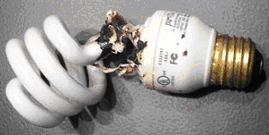CFL Hazards
Serious Business...

|
If you think that the only problem with Compact Fluorescent Light Bulbs (CFLs) is safe disposal .... we've got news for you. CFL's can also be a source of health hazard, toxic fumes and a fire hazard. Ask the Rick Jenkins family in Maryland who had their house burned to the ground because they connected a CFL to a dimmer switch.
|
|
|
A rather sobering article in Australia's Investigative Magazine reveals information from entities like the US EPA and Main Department of Environmental Protection as well of other New Zealand sources on the hazards of CFLs. Should we be embracing CFLs as the salvation of our energy crisis or even as eco or human friendly products?
|
|
|
Government agencies have been promoting use of CFLs as a means of advancing energy conservation in countries such as the US and Australia. They have information that allows them to know the hazards involved in these products which they appear to be ignoring. Looming ahead are laws that will ban incandescent lighting and force us to chose an alternative. Should that alternative really be CFLs?
|
|
|
An Investigate Magazine article outlines several problems with CFL bulbs:
|
|
|
Health Hazard
|
|
|
Mercury is a neurotoxin and it bioaccumulates.
CFLs contain an average of 5 mg (range of 0.9 to 18 mg) of mercury. Breaking a single CFL bulb in a room can result in mercury vapor levels 300 times in excess of what the EPA has established as safe for prolonged exposure. Serious health effects are associated with mercury exposure. Unborn and young children, elderly and those with weakened health are particularly vulnerable. Mercury affects the nervous system. Neuro-pathways of children are still developing and exposure can result in permanent damage. |
This article will certainly give readers pause the next time a CFL is dropped and broken in their home. More than a dust pan and broom will figure into the equation. Investigate Magazine warns "The real cost is not one light bulb breakage, but how badly affected homes will be after 20 years of amateur attempts to clean up one of the deadliest neurotoxins on the planet. A generation of children crawling on mercury-infested carpets would give new meaning to the phrase, "dumbed-down". "If clothing or bedding materials come in direct contact with broken glass or mercury-containing powder from inside the bulb that may stick to the fabric, the clothing or bedding should be thrown away," warns the US EPA." |
|
Fire Risk
|
Reduced Life Span
|
|
CFLs should not be used in track, recessed or inverted fixtures and in addition can not be used with a dimmer switch. Inversion also affects life span of the bulb.
|
The seller claim on life span of a CFL may vary widely. This can be a factor of manufacturing quality. Ever wonder why their warranty is so much shorter than the supposed life span of the bulb?
|
|
Bulb end-of-life hazards: When CFLs burn out they can create acrid plastic smoke and carcinogenic fumes. Those bulbs without an internal fuse will melt or smoke until power is turned off. 90% of these bulbs are currently manufactured in China where quality control is questionable.
|
A recent study shows that the life span of a CFL bulb can be reduced by as much as 85% under normal use due to switching on and off.
|
|
When a CFL bulb is used in an inverted position - bulb down / screw base up - heat which is generated travels upward and can fry the electronic components in the ballast in the base.
|
|
|
Did you know? A CFL is nearly six times more expensive to make in terms of energy consumption.....
|
|
|
Wasted Power
|
Disposal
|
|
The power required from the supplier by a CFL is typically twice what the wattage the bulb states. This "Power Factor" can negate a great part of the savings at the grid level. Also, CFLs create an effect known as "harmonic distortion" by placing an uneven load on the electricity grid, setting up harmonic distortions in the power lines and power stations.
|
CFLs release hazardous amounts of mercury into the air when they break and thus must be recycled or disposed of at a proper facility. A recent environmental agency report estimates the potential cost to recycle one disposal container (wheelie-bin) of approximately 240 liters or 63.4 US gallons of CFL bulbs at $1,300. This cost ultimately falls on the taxpayer.
|
